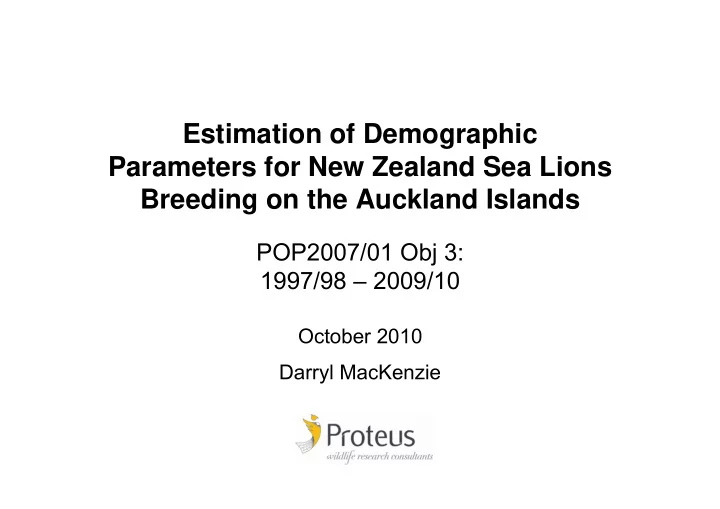

Estimation of Demographic Parameters for New Zealand Sea Lions Breeding on the Auckland Islands POP2007/01 Obj 3: 1997/98 – 2009/10 October 2010 Darryl MacKenzie
Survival and Reproduction • 2 key demographic processes • Can be estimated from tag-resight data using mark-recapture methods • Previous report highlighted importance of accounting for tag-loss • Artificially inflates mortality rates • Sightability may be different for breeders/non-breeders, branded animals, number of flipper tags
Survival and Reproduction • 4 components to model tag-resight data – Number of flipper tags each year – Survival from one year to next – Whether female breeds in a year – Number of sightings in a year
Survival and Reproduction • Number of flipper tags in year t is multinomial random variable with 1 draw and category probabilities ( π ’s) that depends on number of tags in previous year (allows for non-independent tag loss) Number of tags in year t 0 1 2 0 1 0 0 Number of tags 1 1 − π 1,1 π 1,1 0 in year t -1 2 1 − π 1,2 − π 2,2 π 1,2 π 2,2
Survival and Reproduction • Given female is alive, it’s age and breeding status in year t -1, whether it is alive in year t is a Bernoulli random variable where probability of success (survival) is S age,t-1,bred
Survival and Reproduction • Given female is alive in year t , it’s age and breeding status in year t -1, whether it breeds in year t is a Bernoulli random variable where probability of success (breeding) is B age,t,bred
Survival and Reproduction • 3 age-classes used for survival/reproduction: 0-3, 4-14, 15+ • OR, constant for 0-3, and logit-linear for age 4+ • Survival and breeding probabilities = 0 for “breeders” in 0-3 age class
Survival and Reproduction ( ) = μ + ε ε σ 2 y , N 0, a t b , , a b , t b , t b , b y e a t b , , θ = + a t b , , y 1 e a t b , , • Annual variation depends upon previous breeding status
Survival and Reproduction • Given female is alive, it’s breeding status, presence of a brand, PIT tag and number of tags in year t , the number of times it’s sighted during a field season is a zero- inflated binomial random variable with a daily resight probability p t,bred,brand,tags • 3 models: no inflation, time constant inflation, time varying inflation
Survival and Reproduction • Branded animals have the same resight probability regardless of number of flipper tags. • Animals with no flipper tags can only be resighted if they are chipped or branded. • PIT tags have no effect on the resight probability if the unbranded animal has 1 or more flipper tags. • There is a consistent odds ratio ( δ ) between resighting animals with 1 and 2 flipper tags. • Resight probabilities are different for breeding and non- breeding animals. • Resight probabilities vary annually.
Survival and Reproduction p t,bred,brand - applies to all females with brand - applies to unbranded females p t,bred,chip with no flipper tags - applies to unbranded females p t,bred,T1 with one flipper tags - applies to unbranded females p t,bred,T2 with two flipper tags
Survival and Reproduction • Posterior distributions for parameters can be approximated with WinBUGS by defining a model in terms of the 4 random variables • Some outcomes are actually latent (unknown) random variables, but their ‘true’ value can be imputed by MCMC • Equivalent to a multi-state mark-recapture model
Survival and Reproduction • 2 chains of 25,000 iterations • First 5,000 iterations discarded as burn-in • Prior distributions: • μ ’s ~ N(0,3.78 2 ) • σ ’s ~ U(0,10) • Other probabilities ~ U(0,1) • π X,2 ~ Dirichlet(1,1,1) • ln( δ ) ~ N(0,10 2 ) • Chains demonstrated convergence and good mixing
Survival and Reproduction • Model deviance can be calculated and compared for each model • Same interpretation as for maximum- likelihood methods (e.g., GLM), but has a distribution not single value • Comparison of distributions a reasonable approach to determine relative fit of the models
Survival and Reproduction • Fit of model to the data can be determined using Bayesian p-values with deviance as test statistic • For each interaction in MCMC procedure, a simulated data set is created using current parameter values, and the deviance value calculated • Frequency of simulated deviance values > observed deviance values provides a p-value for model fit
Survival and Reproduction: Data • 1990-2005 tagging cohorts • Resights from 1997/8-2009/10 in main field season at Enderby Island • Only considered confirmed breeders at this stage (status = 3)
Survival and Reproduction: Data • Retagged females dealt with using the Lazarus approach • Approximately 2300 tagged females included in analysis
Results (stricter defn.) 2.5 th 97.5 th Model Median B. p- Percentile Percentile value ψ AC 330381 330872 331335 0.21 a t b , , ψ AC 330700 331100 331500 0.22 a b , ψ = AC 340397 340775 341138 0.02 1 ψ Linear 330389 330843 331292 0.23 a t b , , ψ Linear 330600 331036 331437 0.25 a b , ψ = Linear 340372 340753 341118 0.03 1
Results (strict defn.) • Tag loss Tags at t -1 Tags at t Probability 1 0 0.11 (0.10, 0.13) 1 0.89 (0.87, 0.90) 2 0 0.04 (0.03, 0.06) 1 0.14 (0.13, 0.16) 2 0.81 (0.80, 0.83)
Non-breeder in t -1 survival
Breeder in t -1 survival
Non-breeder in t -1 repro.
Breeder in t -1 repro.
Non-breeder in t -1 survival
Breeder in t -1 survival
Survival vs Age
Non-breeder in t -1 repro.
Breeder in t -1 repro.
Breeding vs Age
Recommend
More recommend